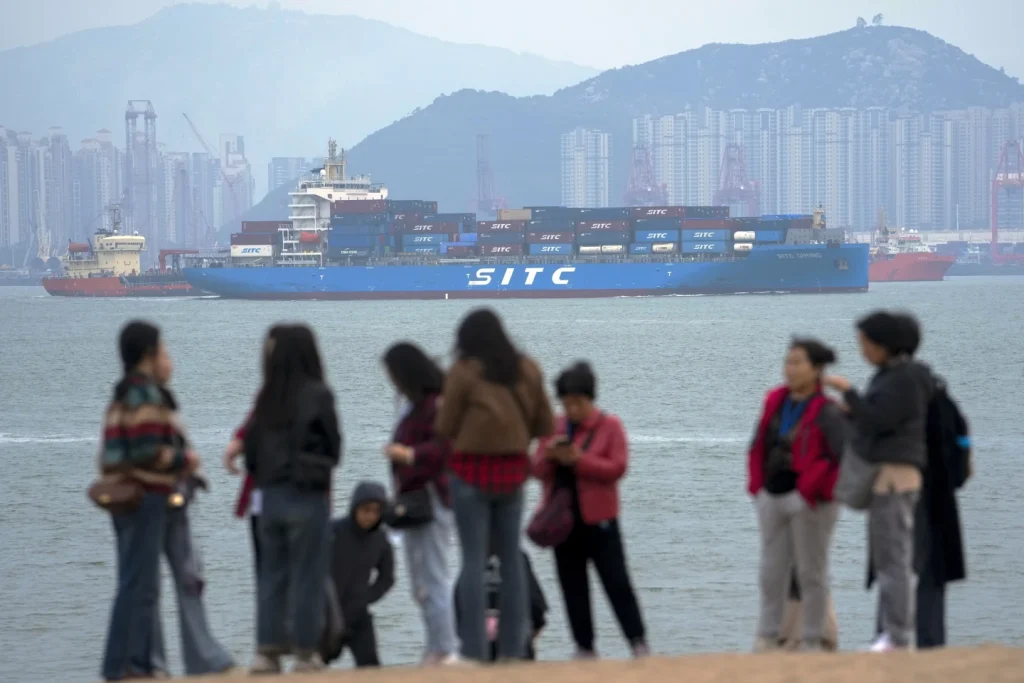The recent survey of factory managers in China, revealing a contraction in manufacturing in December, has raised concerns about the state of the world’s second-largest economy.
The official purchasing managers index (PMI) falling to 49 last month, indicating weak demand, has sparked discussions about the potential implications of this trend.
This essay aims to explore the significance of China’s manufacturing contraction and its potential impact on the global economy.
The National Bureau of Statistics reported that the PMI fell to 49 in December, marking the third consecutive month of contraction.
This downward trend, with the index falling in eight of the past nine months, highlights the challenges faced by China’s manufacturing sector. The scale of the PMI, where 50 serves as the threshold between expansion and contraction, underscores the severity of the situation.
The decrease in the PMI from 49.4 in November to 49 in December indicates a sustained decline in manufacturing activity.
The prolonged contraction in China’s manufacturing sector raises concerns about the overall health of the country’s economy.
Weak demand, as indicated by the PMI, could lead to reduced production, layoffs, and decreased consumer spending. Moreover, the impact of China’s manufacturing contraction extends beyond its borders, affecting global supply chains and trade dynamics.
Given China’s significant role in the global economy, any disruption in its manufacturing sector has far-reaching consequences.
Despite the challenges posed by the manufacturing contraction, it is essential to acknowledge China’s economic resilience. The country’s economy grew at a 5.2% pace in the first three quarters of the year, demonstrating a degree of stability amidst the ongoing global uncertainties.
Moreover, signs of improvement in November, such as the rise in factory output and retail sales, signal potential recovery in the coming months.
However, the sustainability of this recovery remains uncertain, especially in the face of persistent manufacturing contraction.
China’s manufacturing contraction adds a layer of complexity to the global economic landscape. As an integral player in international trade and supply chains, any disruption in China’s manufacturing sector reverberates across the world.

The interconnected nature of the global economy means that a slowdown in China can impact other economies, affecting trade volumes, commodity prices, and investor confidence.
Therefore, policymakers and businesses worldwide are closely monitoring the situation in China and its potential implications for the broader economic environment.
In response to the manufacturing contraction, Chinese authorities may consider implementing measures to stimulate domestic demand and support the manufacturing sector.
This could involve targeted fiscal and monetary policies aimed at boosting consumption, incentivizing investment, and providing assistance to struggling industries.
Additionally, efforts to enhance the resilience of supply chains and diversify trade relationships may be explored to mitigate the impact of manufacturing disruptions.
The survey of factory managers in China, revealing a contraction in manufacturing, has significant implications for the country’s economy and the global economic landscape.
The challenges posed by weak demand and sustained contraction raise concerns about the potential ripple effects on trade, investment, and overall economic growth.
While China has demonstrated resilience and signs of recovery, the sustainability of this trajectory remains uncertain.
As the world closely monitors developments in China’s manufacturing sector, proactive policy responses and strategic business decisions are essential to navigate the evolving economic dynamics.
In conclusion, the manufacturing contraction in China underscores the interconnectedness of the global economy and the need for coordinated efforts to address economic challenges.
It serves as a reminder of the importance of adaptability, resilience, and collaboration in navigating uncertain times.

In recent months, the Chinese government has implemented a series of economic measures aimed at stimulating domestic demand and sustaining growth.
These measures include increased spending on infrastructure, lowered interest rates, and relaxed restrictions on home-buying.
The goal is to counter the impact of the pandemic response, which involved factory shutdowns and city-wide restrictions. As a result, China’s leader, Xi Jinping, has expressed confidence in the country’s economic resilience and dynamism.
However, the global implications of these measures are significant, particularly in the context of the ongoing challenges faced by the world economy.
The Chinese government’s decision to raise spending on the construction of ports and other infrastructure is a clear indication of its commitment to bolstering economic activity.
By investing in infrastructure, China aims to create jobs, drive economic growth, and enhance the country’s overall competitiveness.
Additionally, the reduction in interest rates is intended to lower borrowing costs for businesses and consumers, thereby encouraging spending and investment.
Furthermore, the relaxation of curbs on home-buying seeks to revitalize the real estate sector, a crucial component of China’s economy.
In his New Year speech, President Xi Jinping highlighted the successful transition from the pandemic response to a more resilient and dynamic economy.
His remarks, reported by the official Xinhua News Agency, underscored China’s confidence in its ability to navigate the challenges posed by the pandemic and its aftermath.
Xi’s assessment of the country’s economic strength reflects a sense of optimism and determination to overcome the obstacles faced in the recent past.
The global economy has been grappling with the impact of inflation and its subsequent effects on demand for manufactured goods. Central banks worldwide have responded by raising interest rates, aiming to curb inflationary pressures.
However, this has led to a slowdown in global demand, with ramifications felt across various regions. China, as a major manufacturing hub, plays a pivotal role in the global supply chain, affecting many Asian countries that are reliant on its production capabilities.
The measures taken by China have reverberated across the region, especially in countries with close economic ties to China.
The slowdown in global demand for manufactured goods has had a cascading effect on supply chains, disrupting the interconnected networks that underpin regional economic activity.
The resilience and dynamism of China’s economy, as emphasized by Xi Jinping, have the potential to mitigate some of these disruptions.
However, the extent to which these measures will offset the broader global economic challenges remains uncertain.

China’s recent economic stimulus measures, including increased infrastructure spending, lowered interest rates, and relaxed home-buying restrictions, reflect a concerted effort to boost domestic demand and sustain economic growth.
President Xi Jinping’s affirmation of China’s economic resilience underscores the country’s confidence in overcoming the challenges posed by the pandemic.
However, the global implications of these measures, particularly in the context of subdued global demand and disrupted supply chains, necessitate a comprehensive understanding of their potential impact on the broader regional and global economy.
As the world continues to navigate the complexities of post-pandemic recovery, China’s economic policies and their repercussions warrant close observation and analysis.
The reliance on exports to drive economic growth in China has been a topic of discussion and analysis in recent times.
Stephen Innes, a prominent figure at SPI Asset Management, has emphasized the potential challenges associated with this strategy.
In a commentary, he highlighted the increased competition that comes with the government’s continued investment in industrial construction.
Innes pointed out that the primary constraint on the manufacturing sector is not access to capital, but rather weak demand. Therefore, an expansion of manufacturing investment may lead to an increase in excess capacity.
In December, China’s non-manufacturing Purchasing Managers’ Index (PMI) saw a rise to 50.4, as reported by the statistics bureau.

However, the sub-index for the service sector PMI remained at 49.3, unchanged from the previous month’s reading.
Despite a downturn in the housing market, triggered by a crackdown on excessive borrowing by property developers, the construction industry has shown resilience.
The sub-index for this sector surged to 56.9 in December, indicating substantial expansion, compared to 55 in November.
The dynamics of China’s economic landscape, as depicted by these statistics, raise important considerations for policymakers, businesses, and investors.
The reliance on exports as a driving force for growth underscores the interconnectedness of the global economy. It also underscores the need for China to navigate challenges such as increasing competition and potential overcapacity in the manufacturing sector.
The commentary by Stephen Innes sheds light on the nuanced nature of China’s economic development. While the expansion of manufacturing investment may seem like a positive step, it is crucial to address the underlying issue of weak demand.
This necessitates a comprehensive approach that goes beyond mere capital infusion. It calls for strategies to stimulate domestic consumption and bolster the service sector, which has shown a stagnation in its PMI sub-index.

The contrasting performance of the construction industry amidst a housing market downturn raises questions about the sustainability of this sector’s growth.
It prompts an examination of the factors driving this expansion and the potential implications for the broader economy.
Furthermore, it underscores the need for prudent regulatory measures to ensure stability and prevent speculative bubbles.
As China grapples with these economic dynamics, it is imperative for stakeholders to consider the broader implications.
For policymakers, this may involve recalibrating strategies to foster sustainable and inclusive growth. It may necessitate a shift towards policies that prioritize quality and efficiency over sheer expansion.
For businesses, it underscores the importance of adaptability and diversification in the face of evolving market conditions. For investors, it calls for a discerning approach that accounts for both opportunities and risks inherent in China’s economic landscape.
The interplay of these factors underscores the complexity of China’s economic trajectory. It highlights the need for a multifaceted approach that addresses not only immediate challenges but also the long-term sustainability of growth.
It emphasizes the importance of balancing export-driven expansion with measures to fortify domestic demand and mitigate potential imbalances.
In conclusion, the commentary by Stephen Innes and the recent economic indicators from China offer valuable insights into the intricacies of its economic landscape.
They underscore the need for a holistic approach that addresses the challenges and opportunities arising from the reliance on exports, the dynamics of the manufacturing and service sectors, and the resilience of the construction industry.
As China navigates these dynamics, it is essential for stakeholders to adopt a forward-looking and adaptive mindset to foster sustainable and balanced economic growth.
In summary, the reliance on exports to fuel growth in China presents both opportunities and challenges. The commentary by Stephen Innes and the recent economic indicators from China provide a nuanced perspective on the complexities of its economic landscape.

This necessitates a comprehensive approach that addresses the underlying issues of weak demand, the dynamics of the manufacturing and service sectors, and the resilience of the construction industry.
As China navigates these dynamics, it is imperative for stakeholders to adopt a forward-looking and adaptive mindset to foster sustainable and balanced economic growth.
